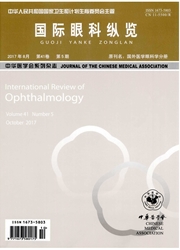

 中文摘要:
中文摘要:
高度近视是由多基因和环境因素相互作用引起的一种复杂性疾病,遗传因素似乎是一个主导因素,但其发病机制尚未完全阐明。全基因组关联分析以单核苷酸多态性为对象,是目前研究高度近视遗传基础较好的方法。研究表明341个基因位点与近视有关,其中,高度近视的可疑致病基因有OPNlLW、NYX、UHRF1BP1L、PTPRR、PPFIA2、IGF—J、LUMICAN、DECORIN、TGF131、RASGRFl、GJD2、LOXL3、APLP2、ZNF644,这为研究高度近视的遗传因素提供了依据。另外,人口研究表明,室内近距离工作或学习、社会经济地位、教育程度、家庭收入水平、血清25(OH)D浓度、户外活动均在一定程度上影响近视的患病率。
 英文摘要:
英文摘要:
It is generally believed that high myopia is a complex disease caused by the interaction of multiple genes and environmental factors. Recent studies have shown that genetic factors seem to be a dominant factor. However,the pathogenesis remains unclear. Genome-wide association studies use high through put genotyping technologies to genotype single-nucleotide polymorphisms and relate them to the diseases. It has been the best method used in high myopia genetic research. Previous studies have indicated that 341 loci are associated with myopia,and studies on high myopia have found suspicious pathogenic genes--OPN1LW, NYX, UHRFIBP1L, PTPRR, PPFIA2, IGF-1, TGFB1, RASGRF1, GJD2, LOXL3,APLP2,ZNF644,and so on. This provided the basis for studying the genetic factors of high myopia. Furthermore, population stud- ies in recent years show that indoor close distance work or study, socioeconomic status, education level, family income level, serum 25 (OH)D concentration, outdoor activities to a certain extent affect the prevalence of myopia.
 同期刊论文项目
同期刊论文项目
 同项目期刊论文
同项目期刊论文
 期刊信息
期刊信息
